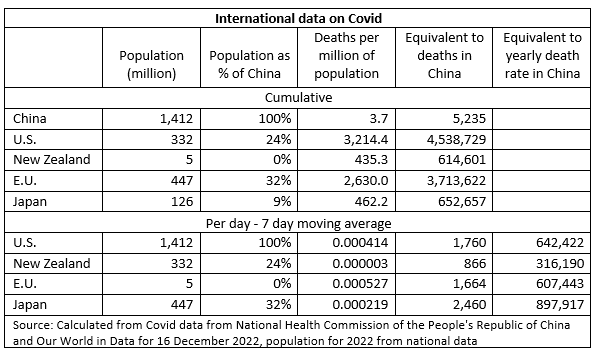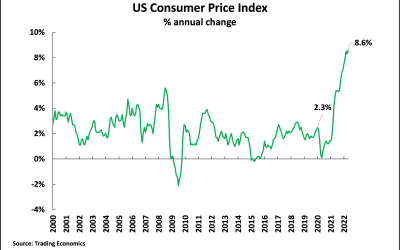In the three years of fighting Covid China has far outperformed the U.S. and other Western countries both in terms of health and saving lives and in economic growth. This article, originally published in Chinese at Guancha.cn summarises the key facts on this,
Introduction
China’s change in Covid policy took place at almost the end of 2022. This was when most economic data for the year was also known. This therefore makes possible a comprehensive balance sheet of China’s performance since the beginning of the Covid pandemic in terms of both health and the economy – and therefore allows a clear comparison to be made of this to the results in “the West”. The factual conclusion which follows from such a study is simple: China’s performance in both health and economy during the pandemic is in international comparative terms little short of a miracle – above all in comparison to the Western countries. In contrast the U.S. and Europe suffered their worst combined health and economic disaster since World War II – in the case of the U.S. the worst for over 100 years.
Taking first the most important question, saving human lives, making a comparison in per capita terms to the U.S.’s death rate, China has saved the lives of the equivalent of more than 4.5 million people in China. Compared to the E.U. it has saved the equivalent of 3.7 million Chinese lives.
To give a measure of the international comparison to China, if the world per capita death rate from Covid had been kept as low as China’s there would only be 29,000 Covid deaths globally instead of 6.7 million, while in the U.S. there would have been only 1,200 deaths instead of the 1.1 million which actually occurred. So disastrous has U.S. performance been during Covid that U.S. life expectancy fell by more than two years during 2019-21 – whereas China life expectancy has continued to rise steadily. So great is the impact of this U.S. failure that after the pandemic China’s life expectancy, at 78.2 years, is now significantly higher than the U.S.’s 76.4 years.
In terms of economic performance during the pandemic while, as is well known, China’s economy slowed its growth has been three times as fast as the U.S. and more than five times as fast as the E.U.. Indeed, 2022 was one of the worst years in U.S. and E.U. economic history, with their experiencing their most severe stagflation for almost half a century. Simultaneously in 2022 so negative were the effects of the economic policies pursued in the U.S. that all groups, both wage earners and capitalists, sharply lost income and wealth. U.S. real weekly inflation adjusted wages fell by 4.4% while the combined annual financial losses on U.S. shares and bonds was the worst since 1932 – and on some measures since 1871. This factually destroys the claim of the U.S. that while the West may have suffered many more deaths than China from Covid its refusal to implement effective lockdowns led to a superior economic performance. On the contrary, during Covid, China vastly outperformed the West not only in terms of saving lives, in health, but also in terms of economic results.
This health and economic achievement during the international fight against Covid is therefore one of the most significant in China’s history. This, naturally, is not meant to imply no problems have been created in China by a global disaster of the scale of Covid – this would be objectively impossible. But, as always in serious matters, it is necessary not to exaggerate in any direction and to keep a strict sense of proportion – there is no virtue in optimism, no virtue in pessimism, only a virtue in realism. The facts show that China’s economy has slowed but that the economic performance in the West was far worse in China. In particular China escaped the severe stagflationary crisis which struck the U.S. and E.U. As China’s economy accelerates in 2023 it is, therefore, vital to learn the severe negative policy lessons of what occurred in the U.S. and E.U. in order for China to avoid any similar problems.
The aim of this article is therefore simple, it is to give a systematic international comparison of China’s performance during the pandemic and in particular a comparison to the West. Such a comprehensive international comparison, and the global lessons of the pandemic period, is necessary to provide the basis for analysing the prospects for China in 2023 and beyond.
As human life is the most important issue the comparison will start with this before proceeding to deal with the economy.
Health
In making international numerical comparisons on health performance during Covid it is important, in order for these to be meaningful, to take into account that China’s population is far higher than that of the U.S. or the E.U., that is the main centres of the West. To be precise, China’s population is 4.3 times that of the U.S. and 3.2 times that of the E.U. Compared to the third smaller centre of capitalism, Japan, China’s population is more than 11 times as large as Japan’s. Therefore, comparisons in terms of absolute numbers, without taking into account differences in population, are highly misleading. The relevant comparison is on a per capita basis, i.e. taking into account the population divergencies.
To avoid any suggestion of distortion in what follows, precise per capita data is given in the appendix. But to best understand comparisons in a common sense/intuitive way, and therefore to evaluate what would be the effect of different policies proposed for China, these are most clearly understood in terms of what such health figures would mean in a country with the population of China. This is therefore also given. The resulting comparison in terms of the cumulative number of Covid deaths, expressed in terms of a country with the size of population of China, is shown in Figure 1.
As may be seen at the time of writing, Mainland China has suffered 5,235 Covid deaths, that is 3.7 per million of the population. In comparison the U.S. has suffered almost 1.1 million deaths, 3,214.4 per million. The U.S. per capita death rate is 869 times higher than China’s. Put in other terms, if China had experienced the same per capita mortality rate as in the U.S. more than 4.5 million people in China would be dead – instead of 5,200.
Making a comparison to the E.U., this has suffered almost 1.2 million deaths, or 2,630.0 per million. The E.U.’s per capita death rate is 711 times as high as China. Put in other terms, if China had experienced the same per capita death rate as the E.U. more than 3.7 million Chinese people would be dead from Covid.
Figure 1 also makes a comparison to New Zealand. The reason for so doing is that although New Zealand is a small country it is an important comparison to China, because until October 2021 New Zealand pursued a successful Zero Covid policy – one consciously copied from China. At the beginning of October 2021, immediately before this policy was ended, New Zealand’s per capita death rate was 5.59 per million, under twice that of China, and equivalent to slightly under 8,000 deaths in a country with the size of population of China. This is, of course, while inferior to China, nevertheless vastly superior to the data given above for the U.S. and E.U. When this policy was lifted, as Figure 1 shows, New Zealand’s deaths began to rise and, at the time of writing, they had reached 435 per million of the population. This is 118 times the level of China, and equivalent to 615,000 deaths in a country with the population of China. But this level of deaths is still only, in per capita terms. 14%, one seventh, of the death rate in the U.S. In short New Zealand’s policy saved enormous numbers of lives compared to the U.S. and E.U..
Figure 1
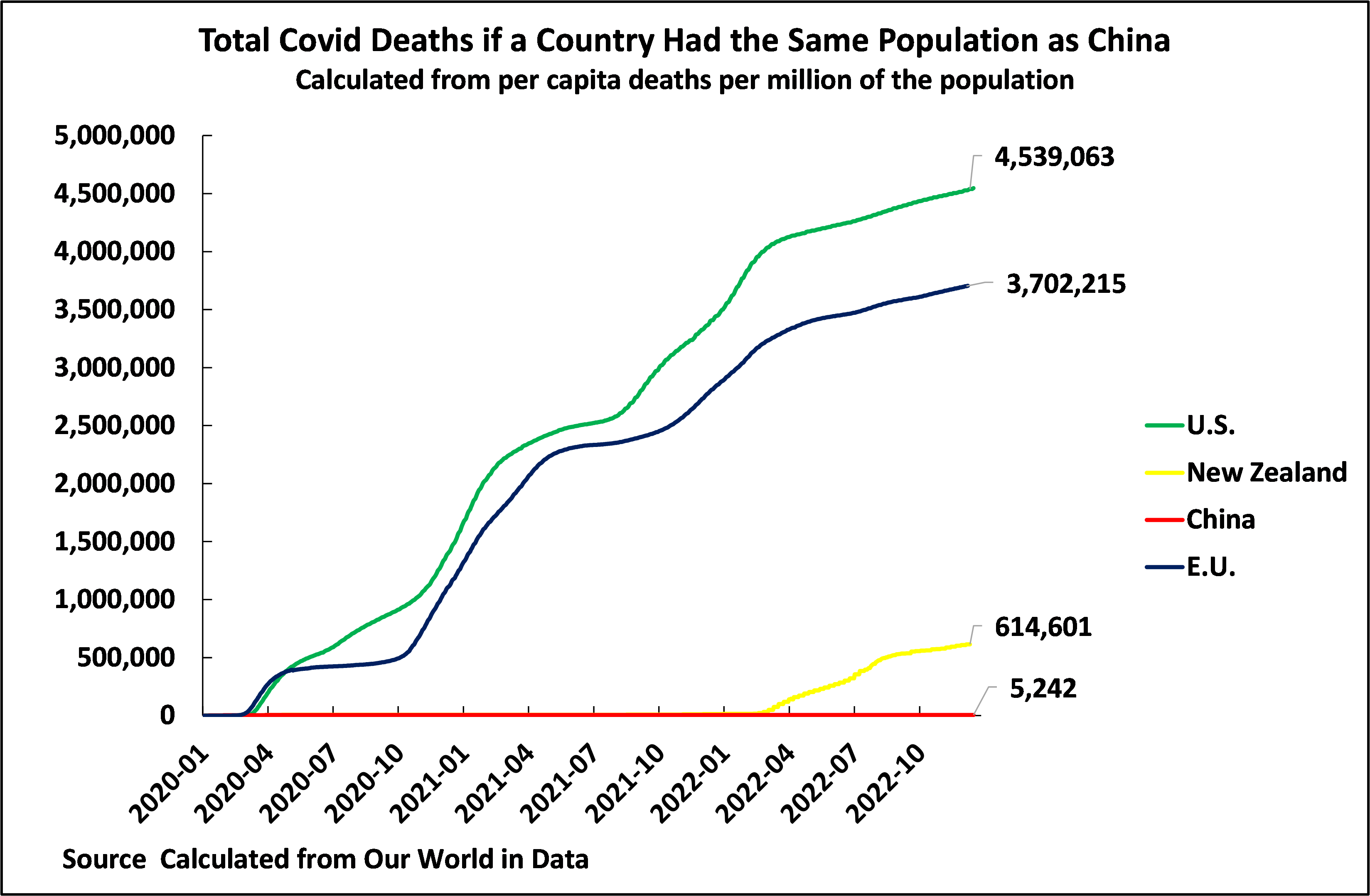
Creating the time for medical treatments
The reason for these huge differences in death rates between countries shown above are evident. At the time Covid broke out, precisely because it was new, there were no significant specific medical means either to prevent it or to greatly ameliorate its effects – no vaccines, no known effective medications, no experience of hospital staff to develop the most effective treatment methods etc. The only proven effective measures were non-medical ones, that is the lockdowns introduced by China.
Therefore, those countries that did not immediately start fighting Covid by imposing these lockdowns, or only doing so in a half-hearted way, such as the U.S. and E.U., suffered disastrous death tolls – each experiencing more than one million fatalities in absolute terms, and equivalent to around four million deaths in a country with the population of China. This is equal to the death toll from a major war. Countries which practiced serious lockdowns, such as China or New Zealand prior to October 2021, on the contrary suffered small loss of life. The lockdowns, therefore, served to save enormous numbers of lives during the period during which vaccines, medicines, and more effective hospital treatments were created and introduced.
Omicron
The result of this was that the later the lockdowns, non-medical interventions, were lifted the more effective had the medical treatments become. For example, although New Zealand began to suffer a significant number of deaths when it lifted its lockdowns in October 2021, it still suffered far less deaths than the U.S. and E.U.. China, the last major country to lift lockdowns, therefore had by far the least deaths of any major country.
In parallel, the time bought by the lockdowns simultaneously gave time for the virus to become less virulent. It was not impossible to foresee this in advance. It is a misunderstanding to believe that what drives the successful evolution of any virus is success in killing its host, that is people. Like any other biological being the success of the virus, its “goal”, is to reproduce itself, its DNA, as much as possible. To be extremely deadly should therefore not be understood to be an advantage for a virus. A virus is propelled by its success in replicating itself, not its effect on its host.
One of the reasons, for example, that Ebola has not become a pandemic is because it so deadly, with an approximately 50% mortality rate, and kills its host rapidly. This actually creates difficulty for Ebola to spread compared with a disease which has a lower mortality rate but is extremely transmissible – a person with Ebola may well die before they have time to mix with and infect very large numbers of people. In contrast, one of the reasons Covid could spread so rapidly was that it was extremely infectious but had a lower mortality rate and took a significant period between being caught and killing its host. During most of that period of time the person infected with Covid could potentially mix with people and therefore spread the virus. A virus which is extremely transmissible, but not necessarily ultra-deadly, therefore may be more effective in spreading itself than one which kills an extremely high proportion of its hosts very rapidly. This evolutionary advantage therefore creates the possibility that some viruses will become milder with time – although this is not a certainty as, for example, the smallpox virus for centuries, indeed throughout the whole of known human history, continued to be extremely deadly and was finally overcome only with the invention of vaccines. Similarly, the Delta variant of Covid was more serious than the original strain, while Omicron was milder in its effects.
This possibility for a virus to become milder was why, for example, the last comparable pandemic to Covid, the deadly “Spanish flu” after World War II, which killed as many as 50 million people, eventually ceased to kill large numbers. There were at that time no effective vaccines against Spanish flu but due to the combination of large numbers of people becoming immune through infection, and the possibility for the virus to become milder, it eventually ceased to become a mass killer during the early 1920s. Omicron, in that sense, is extremely efficient as a virus – it is ultra-transmissible but less deadly that previous Covid variants such as Delta.
Therefore, these two reasons – time available to develop improvements in medical treatments and the possibility for the virus to become less virulent – made the time gained by lockdowns invaluable and shows why claims that China is now in the same place as the West are totally false. As the facts show, those countries which did not impose strict lock downs suffered literally millions of unnecessary deaths. This is why China, by its strict lockdown policy, saved literally millions of Chinese lives.
The devastating effect on the U.S. of its Covid policy
Turning from the cumulative number of Covid deaths to the continuing situation today, the situation is also clear. U.S. daily Covid deaths are still equivalent to 1,792 a day in a country with the population of China – equivalent to 650,000 deaths a year in a country with China’s population. The E.U.s daily Covid deaths are equivalent to 1,665 a day in a country with the population of China – equal to a death rate of 600,000 a year.
These death rates are of course less catastrophic than before the Western countries began medical interventions with vaccines and medicines. At the peak of the pandemic, in January 2021, the annualised daily death rate in the U.S. would have been equivalent to more than five million deaths a year in a country with the population of China. But a continuing death rate in the U.S. equivalent to 650,000 a year in a country with the population of China is far from trivial. One of the reasons for this is that the U.S. not only abandoned lockdowns but also abandoned other non-medical interventions such as mask wearing. This is why China is so correct to insist on rejecting the “lying down” policies of the West.
Overall, it is clear that the result of these Covid death rates in the U.S. have been catastrophic for the country – as is shown in Figure 2. On the new official figures, in 2021 U.S. life expectancy fell to 76.4 years – down from 78.8 years in 2019. In only two years, U.S. average life expectancy fell by 2.4 years. In contrast in China life expectancy in 2021 rose to 78.2 years, up from 77.9 years in 2020 and 77.3 years in 2019. Prior to the pandemic, in 2019, U.S. life expectancy was 1.5 years longer than in China. By 2021 China’s life expectancy was 1.8 years longer than the U.S. This is a measure of the scale of the Covid health disaster that unfolded in the U.S..
Figure 2
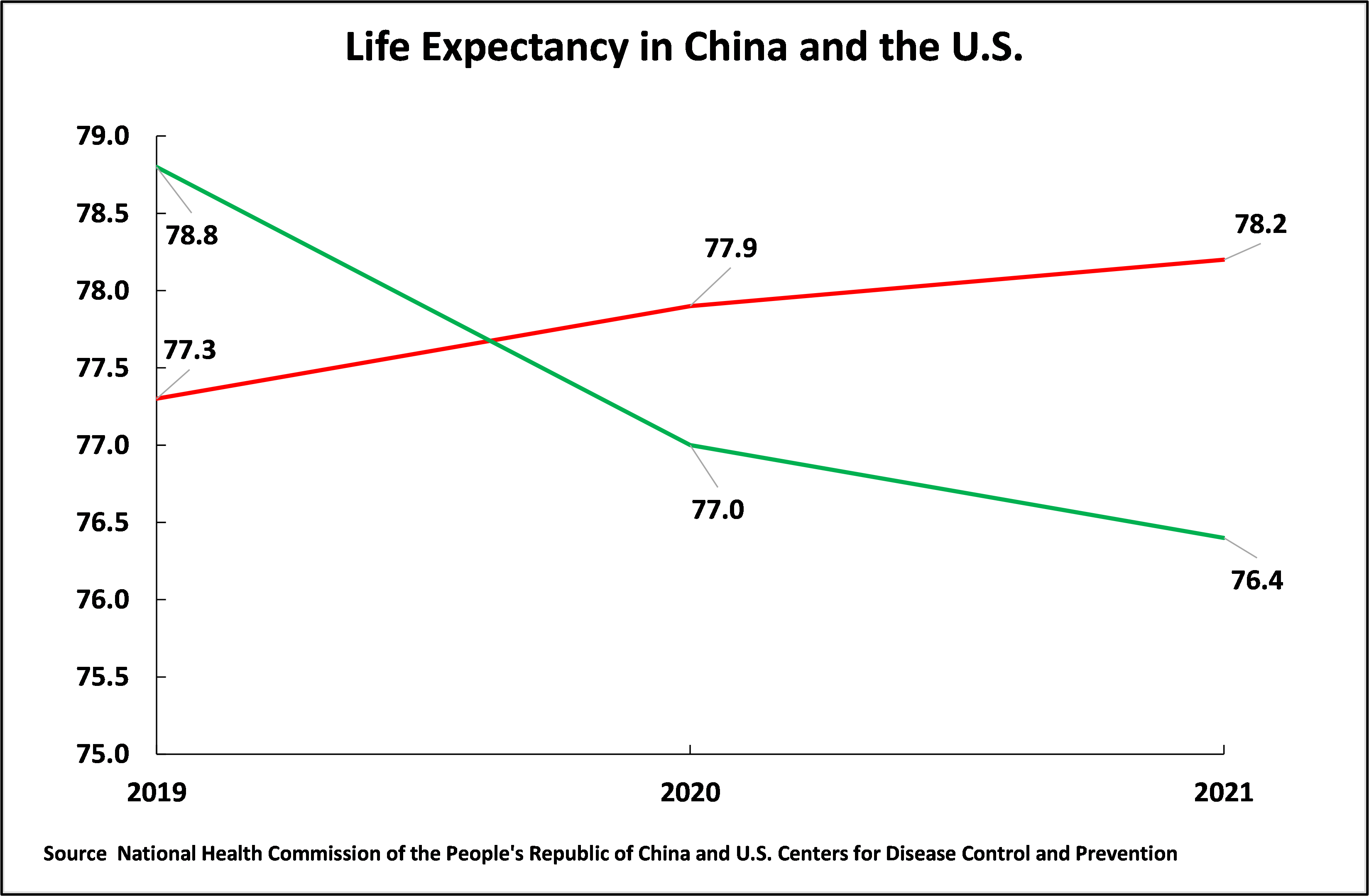
The Western economies – slow growth
Turning to the economy, it is of course well known that China’s economy slowed due to the impact of Covid. But for any balanced and comprehensive analysis it is necessary, in an overall negative global economic situation, to make an international comparison. China’s economy still far outperformed the West – as Figure 3 shows. During the three years up to the latest available data, for the third quarter of 2022, China’s economy grew by a total of 14.3%, the U.S. by 4.8%, and the E.U. by 2.8%, while Japan’s economy contracted by 1.9%. That is, China’s economy grew three times as fast as the U.S. and five times as fast as the E.U.. This far worse economic performance of the West compared to China is even clearer when the second aspect Western economic policy during the pandemic, resulting in a massive inflationary wave, is analysed – as considered below.
Such growth data immediately shows that the claim by the U.S. that, because they did not lock down, Western countries may have suffered more Covid deaths but outperformed China economically is a straightforward falsification. On the contrary China’s economic growth far outperformed the U.S. and E.U. during the pandemic – despite the fact that China pursued a strict lockdown policy and the U.S. and E.U. did not.
Figure 3
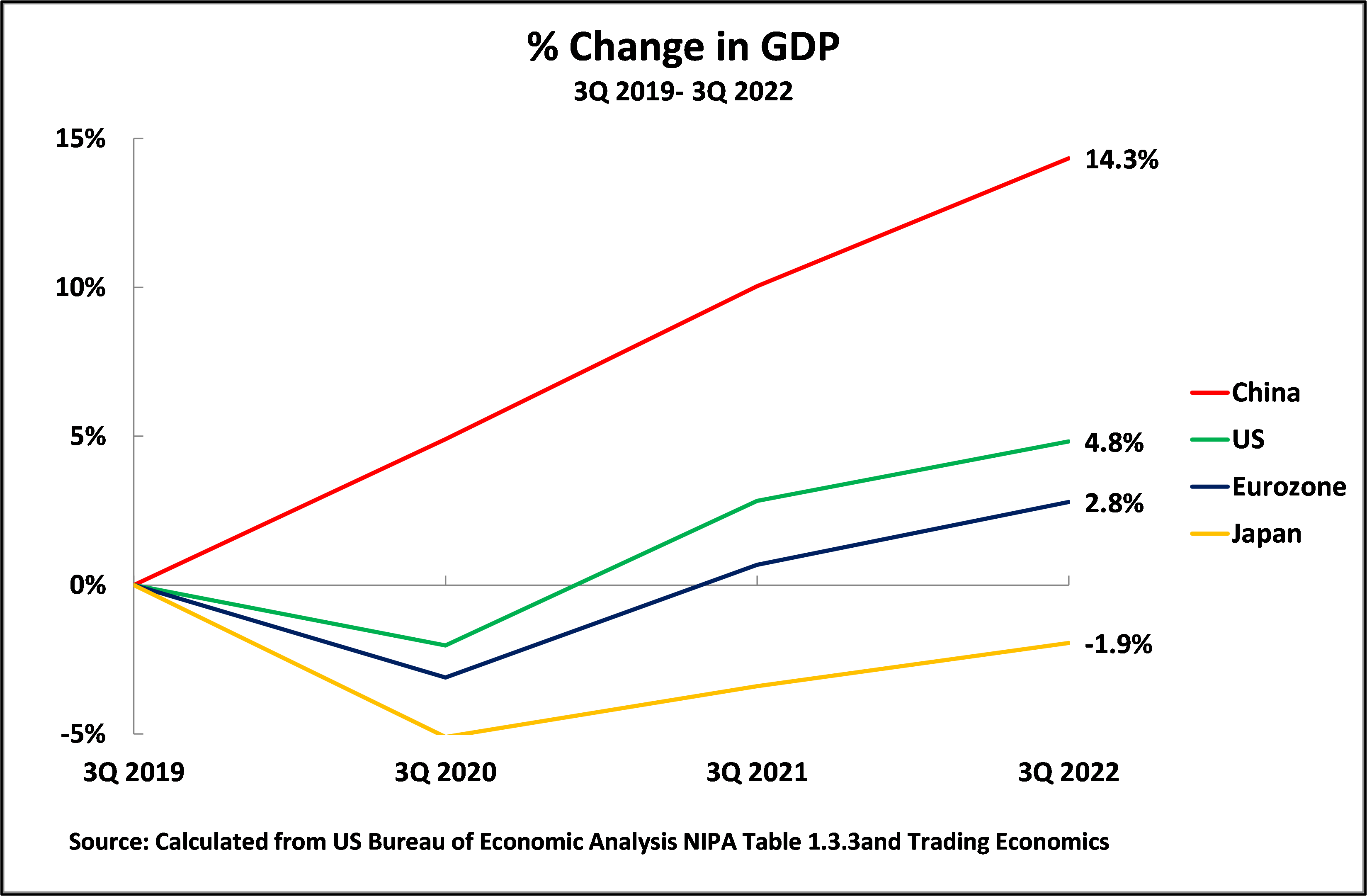
The Western economies – high inflation
The second feature of Western economic trends during the pandemic, which interacts with their slow growth, is extremely high inflation. During 2022 the U.S. and E.U. suffered the worst stagflationary crisis, the combination of high inflation and slow growth, for almost half a century. Inflation rose to its highest level for forty years while GDP growth halved in the same period. Furthermore, it is easy to show that this huge inflationary wave was overwhelmingly due to U.S. economic policy and not the Ukraine war – as over 90% of U.S. inflation took place before the latter conflict broke out. This was analysed in detail in 一场通胀海啸正从美国席卷世界,但肇因不是乌克兰战争.
To attempt to control inflation the U.S. Federal Reserve not only increased interest rates but has made it clear that it will raise them further in 2023 – the only discussion being by how much. U.S. money supply is now actually falling – an extremely rare trend. Such a contractionary monetary policy is directly counter to what is required to prevent economic slowdown. The necessity of such a restrictive monetary policy, to attempt to control unacceptably high inflation, prevents the U.S. taking effective stimulus measures in the coming period to prevent economic deceleration.
In contrast, as Figure 4 shows China suffered no increase in inflation during the global pandemic – on the contrary its price rise level remained below that at its beginning. As can be seen at the beginning of the last three-year period, covering the pandemic, China’s inflation, at 3.0%, was higher than the U.S., at 1.7%, or the Eurozone at 0.8%. But by the latest data, for November 2022, U.S. inflation had risen to 7.1%, and E.U. inflation to 10.1% – in both cases the highest for four decades. Japan’s inflation was far less serious than that of the U.S. or E.U., at 3.8%, but still significantly above China’s. China’s inflation, however, had fallen to 1.6%. Not only did this mean that China’s overall inflationary situation was far better than in the West, but it meant that while the U.S. and E.U. were forced to adopt contractionary policies in 2023, China, which was not under inflationary pressure, has space for reasonable stimulus measures to aid its economic growth.
Figure 4
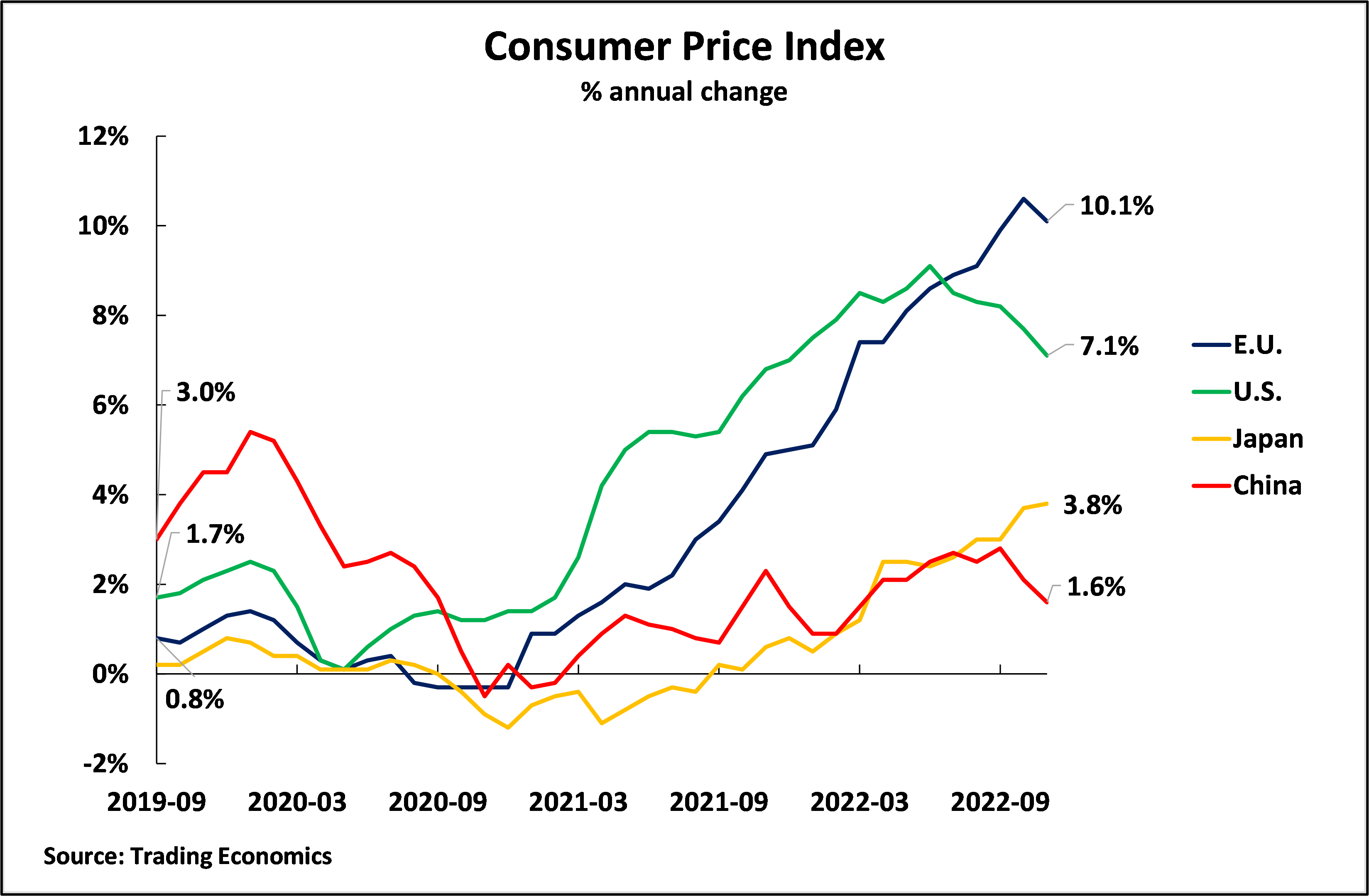
Declines in income and wealth in the West
The extremely negative stagflationary trends in the U.S. economy in turn, produced a situation in which income and wealth for both labour and capital fell sharply in 2022. U.S. real inflation adjusted weekly wages dropped by 3.0% in the year to November 2022, having fallen by 1.4% in the year to November 2021 – a 4.4% decline over a two-year period. Regarding return on capital, up to November, the latest monthly data, during 2022 the combined losses on U.S. stocks and bonds were the worst since 1932 and on some measures since 1871. Total nominal losses on U.S. stocks had been 18% and losses on bonds 17%. U.S. government bonds suffered their worst losses for a year since 1788. Under the impact of such huge losses on financial markets in 2022 not only did real U.S. real wages decline, the most important issue for the mass of the population, but the wealth of the richest Americans fell precipitously – Bloomberg found that U.S. billionaires collectively lost $1.4 trillion in 2022.
Whether measured in macro-economic terms, economic growth and inflation, or in terms of income and wealth, 2022 was therefore a disastrous year for the U.S. It is, therefore, bizarre to find that a small fringe in China consider that it is important to follow the West’s economic response to the Covid pandemic. As was seen this policy was a disaster. It is, indeed, very important for China to study the West’s economic response to the pandemic – in order to avoid the same type of economic debacle and to understand the reasons why it occurred in the West.
Economic performance during the pandemic
Naturally the above does not at all imply that Covid created no economic problems for China – it is not at all to attempt to present a “rosy” picture of the situation. Given the very negative international economic trends, with the E.U. clearly entering a recession next year and the U.S. at a minimum experiencing slow growth, or possibly recession, it will be a considerable effort for China to maintain a satisfactory growth rate in 2023. But it is also necessary to be strictly objective and balanced. China’s economy far outperformed the West during the pandemic both in terms of economic growth and in terms of controlling inflation. Furthermore, due to fact China is not facing the same inflationary situation as the U.S. and E.U, its ability to take measures to deal with economic slowdown is much greater. During 2023 China’s economy, therefore, will continue to far outperform the West.
Overall balance sheet during the international pandemic
Drawing this health and economic data together it is, therefore, possible to draw a comprehensive balance sheet comparing China and the U.S. and E.U., that is the “West’s”, performance since the beginning of the Covid pandemic period. It is difficult to think of a starker comparison. To summarise:
- The West has suffered its greatest combined human and economic disaster since World War II. Both the U.S. and E.U. have suffered over one million deaths in absolute terms. But, as already noted the real comparison to China is far worse than this. In per capita terms, compared to a country with the population of China, the U.S. has suffered the equivalent of 4.7 million deaths and the E.U. 3.7 million. For the U.S. these are a far higher numbers of deaths than in any of the major wars in its history – in comparison 655,000 Americans were killed in the Civil War, slightly over 400,000 in World War II, slightly over 200,000 in World War I, slightly under 60,000 in Vietnam, and 37,000 in Korea. In the Spanish Flu pandemic at the end of World War I 675,000 American’s died. So disastrous has been the impact of Covid on the U.S. that its life expectancy fell by more than two years during the two-year period 2019-2021. In economic terms the U.S. grew at only one third of the rate of China during the three years covering the pandemic period and the E.U.’s economy grew at less than one fifth of the rate of China, while simultaneously both the U.S. and the E.U. suffered the worst inflationary wave for almost half a century.
- In contrast, up to the beginning of December, China suffered only slightly over 5,200 deaths. China’s economy grew three times as fast as the U.S. and five times as fast as the E.U. – while Japan’s economy shrank. Simultaneously, while inflation in the U.S. and E.U. soared inflation in China fell.
None of this means that there were no problems in China. But that these problems were small compared to the debacle that was unfolding in the West. The attempt by the U.S. to claim that China should have learnt from itself, and the echo of this by a few extreme fringe forces in China, is therefore completely ludicrous. The U.S. performance was hugely worse than China’s. The U.S. people suffered appallingly because the U.S. did not learn from China’s success. In the economy it is therefore crucial for China to learn from, and to avoid, the extremely negative consequences of the policies that were pursued in the West and which created the 2022 economic disaster there.
The reality of the Western Covid disaster
Finally, the author’s personal experience is that so protected were China’s people by the policy of the Chinese government compared to the West that it is very difficult for them to understand the scale of the Covid disaster which occurred in the U.S. and E.U.. For example, when he was interviewed about the Covid pandemic by someone who supported the policies of the Chinese government the interviewer, wishing to emphasise the relative failure in the West said if China had not adopted its policy it would have suffered many thousands of deaths. I replied that such a view greatly underestimated the situation, if China had followed the same course as the West it would have suffered millions of deaths – not thousands.
Those who want to criticise various aspects of China’s policy similarly enormously fail to understand the Covid catastrophe in the West. For example, one article I read on the Chinese internet said China’s policy had been incorrect because it had only allowed two million people, which the author of that article clearly considered a huge number, to live three years longer than if the policies pursued in the West had been followed. First this is absurd. Even if it were true, allowing people to live three years longer would be a great achievement – unless the author is volunteering to die three years earlier than necessary! But second, if China had followed a course in line with the U.S. policy not even two million, but four and a half million Chinese people would be dead!
Long covid
Furthermore, the suffering in the West from Covid has not stopped and extends far beyond the huge numbers of dead. Nearly 8% of the entire US population are suffering from long Covid, defined as still having severe symptoms three months after infection. This is over 25 million people in the U.S., or the equivalent of almost 110 million people in a country with the population of China. In Britain a more severe definition of long Covid is given than in the U.S. – that the ability to undertake day-to-day activities had been “limited a lot”. Over 400,000 people in Britain are suffering from this, which would be equivalent to 8.6 million in China.
To turn from statistics to the personal consequences the impact of long Covid can be life changing and devastating. A case relatively well known in the West, due to his campaigning, is that of Ravi Jacques, who is the son of the well-known commentator on China Martin Jacques. Ravi Jacques is a highly talented person with great prospects in life ahead of him. He is a Stanford University scholar who had won a Schwarzman scholarship, a prestigious grant to complete a master’s degree in global affairs at one of China’s premier universities. He was also a talented musician. At the start of 2020, he was on top of the world. Now he wakes up in his childhood bedroom and wonders if it will be a “good day”, which he defines as getting about two hours of activity. The rest of the day, he’ll spend in bed or doing what he calls “existing”: watching television with his eyes shut, trying not to think. For over a year and a half, debilitating fatigue and a constellation of other symptoms have confined him to less than a half kilometre radius around his father’s house.
The Guardian summarised the situation with long Covid in Britain: “According to figures from the Office for National Statistics, more than 2.1 million people in November were still living with Covid symptoms more than four weeks after the first confirmed or suspected infection – about 3.3% of the UK population [equivalent to 47 million people in China]…. However, despite myriad research endeavours, there is as yet no cure beyond natural recovery, which can take time, while only a fraction of people with long Covid have received support from services such as long Covid clinics.”
For older people, and those with special vulnerabilities, their lives have been changed for the worse for the foreseeable future. They cannot go out safely because of their special vulnerability. In particular they are not able to safely go to places where it is impossible to wear masks – for example to eat at restaurants. Meanwhile many Western governments make their lives even more threatened by refusing to encourage mask wearing – or actively discouraging it in many parts of the U.S.. Furthermore, Covid is not something which can only be caught once, many people have had it several times.
The consequences of Covid in the West
This then is the reality of Covid in the West. Millions of dead, tens of millions suffering serious consequences from long Covid, hundreds of millions of older (and other vulnerable) people at risk. Simultaneously U.S. stimulus policies to deal with the economic consequences of the pandemic were so bad that by 2022 they were not only worsening the economic situation of ordinary people but were destroying even the wealth that the richest American’s had gained during the early pandemic period.
The initial economic impact of Covid pandemic, with mass U.S. layoffs and wage cuts, led to increasing wealth for the richest American’s. In the early period of the pandemic billionaires increased their wealth in the U.S. by literally trillions of dollars. As a study of U.S. billionaires noted early during the pandemic: “America’s billionaires have grown $2.1 trillion richer during the pandemic, their collective fortune skyrocketing by 70 percent — from just short of $3 trillion at the start of the COVID crisis on March 18, 2020, to over $5 trillion on October 15 of this year. The $5 trillion in wealth now held by 745 billionaires is two-thirds more than the $3 trillion in wealth held by the bottom 50 percent of U.S. households estimated by the Federal Reserve Board. The great good fortune of these billionaires… is even starker when contrasted with the devastating impact of coronavirus on working people. Almost 89 million Americans have lost jobs, over 44.9 million have been sickened by the virus, and over 724,000 have died from it.”
In parallel with the deaths of ordinary people, while U.S. billionaires were increasing their wealth during the early pandemic period, as the New York Times noted:” The purchasing power of the average worker’s weekly pay declined by 2.3 percent from December 2020 to December 2021.”. The attack on the most vulnerable, such as the old, disabled, and medically disadvantage, who have the highest Covid death rates, is even worse. In short, in the West a literal slaughter of ordinary people took place while in the early period of the pandemic an enormous transfer of wealth took place to the richest in society.
But by 2022 so negative had the stagflationary wave become resulting from U.S, economic policies, and 90% of U.S. inflation occurred before the Ukraine war began, that not only were the living standards of ordinary people falling but, as already seen, huge losses were being suffered by the richest Americans. In short, the stimulus measures which were taken by the U.S. to deal with Covid were extraordinarily negative from every economic viewpoint.
This is the result of the Western governments refusal to learn from China’s policy for dealing with Covid. The Western governments literally allowed mass deaths of their own people – this domestic consequence was in addition to the extraordinarily serious international suffering caused by Western hoarding of Covid vaccines, an issue which merits a separate analysis. Covid was one of the clearest demonstrations ever that the talk of “human rights” in the West is a farce – they just allowed huge numbers in their own populations to be killed and also produced an economic debacle.
The entire framework in which the West dealt with Covid was horrific. People in China should be clear just how lucky they were to be protected by the policies of the Chinese government – as the data given in this article shows.
It is therefore to witness a farce when the author reads about the handful of people in China who think it should have followed the West’s policy for dealing with Covid and protested because it didn’t. They were supporting a policy that would literally have killed millions of their own countrymen and women.
The cynicism of Western governments and media
All this also shows the cynicism, and complete lack of reality of the Western governments, and most of its mass media, when they now attempt to give lessons for China. Not only the “popular” but the so called “serious” Western media contributed to this disaster. They concealed failure of their governments both in health and the economy. They have prevented learning from China. This has continued to the present.
Take for example the front page of The Economist, a supposedly serious Western journal, on 3rd December. Its headline was “China’s Covid Failure”. It did not even mention that millions had died in the West and in comparison millions of live had been saved in China! It did not mention that life expectancy in the U.S. had fallen by other two years! Apparently human lives count for very little. It did not mention that the economic policies in the West had unleased the worst stagflationary crisis for almost half a century. Any factual analysis shows that in comparison to the disaster in the West the results of China’s policy, both in terms of health and the economy, was an enormous success
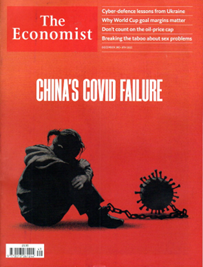
Conclusion on the economy
In this article the author has deliberately concentrated more on the impact on human lives of Covid than on the economy – because he entirely agrees with a “people centred” policy. The economy exists to serve people’s lives, not people to serve the economy. Nevertheless, it is worth concluding with examining the economy – because in the long term the economy is key to improving people’s lives.
The rationale of the Western governments for allowing millions of people to die was that it would allow their economies to grow – as supposedly contrary to the policy of China which was accused of slow growth. In reality, as was seen, this was a lie by Western governments and mass media – the U.S. economy grew only one third as fast as China and the E.U. only a fifth as fast as China. But the economic prospects are now clear. China has already far outperformed the Western economies during the pandemic. This will continue in 2023. Not only are the economies of the U.S. and E.U. slowing already but their high inflation means their tight monetary policy will slow their economies in 2023. In contrast China’s low inflation means it has space for reasonable economic stimulus measures. China’s economy will far outperform the U.S. and E.U. in 2023. A part of ensuring this obviously is for China to analyse and learn the lessons from the huge mistakes of Western economic policy which led to their economic calamity in 2022 – a more detailed technical analyses of these was given in in 一场通胀海啸正从美国席卷世界,但肇因不是乌克兰战争 .
In summary, the West’s policies confronted with Covid, compared to China’s, have been both a health and an economic disaster. There have been many demonstrations of the superiority of China’s socialist system compared to Western capitalism. The different policies to deal with Covid are the latest and one of the clearest.
Appendix
In the article, in order to allow the significance of the various numbers regarding Covid to be clearly understood, such as on deaths per million of the population, data has been expressed as what would be the consequences in a country with a population the size of China. To illustrate this, for example, to say that the total deaths in China are 3.7 per million, whereas in the U.S. they are 3,214.4 per million, does not give any real feeling of the impact of what such a number would mean for China. Whereas the fact that a 3,214.4 per million death rate in China, which is that of the U.S., would be over 4.5 million deaths in China shows the real impact very clearly. However, to avoid any suggestion that numbers are being manipulated the table below shows the data in terms of death per million etc. Anyone who wishes can show the numbers in the article are correct by replicating the calculations from the raw data below.
